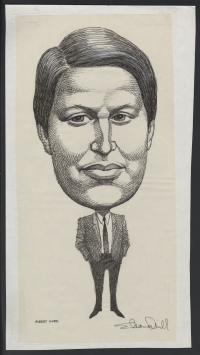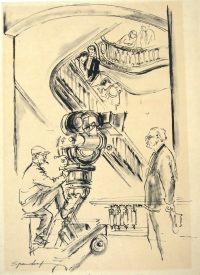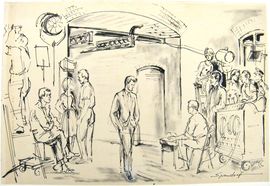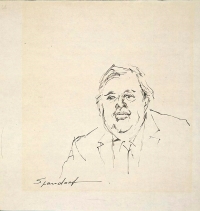
I love the humor you can get out of politics.1
So stated Eleanor Mill about her work as a political cartoonist and caricaturist. Fourteen of her drawings, all featuring the Senate, were donated to the Senate in 2018. The gift, which also included 84 works on paper by the artist Aurelius Battaglia, came from the artists’ daughter, Nicola Battaglia, in memory of her parents. Mill’s drawings represent the most recent addition of works by a contemporary woman artist to the Senate Collection. The drawings join an important group of 70 illustrations by the artist Lily Spandorf, expanding the Senate’s holdings of works by women artists. Together, these collections reflect a range of artistic techniques and showcase key events, buildings, and individuals that helped shape the Senate in the second half of the 20th century.
![Image: [Robert Dole] (Cat. no. 11.00129.092)](/about/resources/graphics/cropped/11_00129_092.jpg)
Eleanor Mill (1927–2008) was born in Michigan. Her father was an executive at General Motors, and the family relocated with such frequency that by the time she graduated from high school, she had attended 21 schools in 18 states. Eleanor trained at the Corcoran School of Art in Washington, D.C., and married Aurelius Battaglia in 1948, although they would later separate. She enjoyed early success illustrating children’s books.
It was not until the middle of her career that Mill found her true calling: political cartooning. The artist reflected on this transformation in an interview she gave to the Hartford Courant in 1988: “I spent a lot of my life doing what other people told me to do, or what other people told me I was good at. I had to get older to realize I could do what I wanted. I love what I’m doing now.” In a second interview in 1992, she discussed how her art served as a form of advocacy: “I’ve always been political, I just never thought I could do anything about it in my work until I got old.” She was well aware how few women artists were creating political art and recalled how an art director at Life magazine once told her agent that “it would be a lot easier for [Mill] if [her] name were Edward.”2
![Image: Al[bert] Gore (Cat. no. 11.00129.090)](/about/resources/graphics/cropped/11_00129_090.jpg)
Mill’s principal focus was people, often without dialogue or background, and her use of pen-and-ink was well suited to newspapers. Mill found that televised news could be one source of inspiration: “I also use my VCR to record people so I can draw them. I don’t like to rely too much on photographs. It’s better to see [people] in movement; you get more personality.”3
Mill self-syndicated her drawings through the Mill News Art Syndicate, and her work appeared, sometimes as illustrations for op-eds, in more than 40 national newspapers. Mill sought to connect readers with topical contemporary issues ranging from politics to homelessness. While she hoped that her drawings focusing on social issues might inspire viewers to action, she had a different intention for her political drawings: “Just make them laugh.”4
![Image: [Robert] Dole (Cat. no. 11.00129.096)](/art-artifacts/resources/graphics/large/11_00129_096.jpg)
The Senate’s Eleanor Mill collection consists primarily of political cartoons and caricatures of senators and vice presidents that date from the 1980s to the early 2000s. Many of her caricatures, such as those of Albert A. Gore (D-TN) and Robert J. Dole (R-KS) emphasize certain facial features of her subjects, often for humorous effect. She sometimes departed from caricature to provide a more realistic portrayal, such as in a later drawing of Gore. Other caricatures, such as one referencing Dole’s 1996 presidential campaign, include additional detail to anchor the subject in the historical moment.

Lily Spandorf (1914–2000), a native of Austria, worked for the Washington Star as a contributing artist from 1960 to 1981, providing artistic interpretations of news subjects such as the 1968 Democratic National Convention and the White House Easter Egg Roll. Her work can be found in museum collections and in the book Lily Spandorf’s Washington Never More (1988), which showcases more than 70 of her paintings of Washington, D.C., neighborhoods and buildings. Spandorf preferred creating her work “on the spot” and often searched for outdoor locations in which to draw or paint.5
In 1961 the Washington Star assigned Spandorf to sketch scenes from the filming of Otto Preminger’s Advise and Consent , taking place on location on Capitol Hill. After completing the drawings for her initial assignment, she used her press pass over the next several weeks to continue sketching scenes from the filming. “It was exciting and I loved every bit of it,” she recalled in a 1999 interview. Her work caught Preminger’s attention, and at his request her drawings were displayed at the Washington premiere of the film.6

Spandorf worked in pen-and-ink and gouache (a water-based painting technique) to create these drawings, which include numerous views of the Capitol and the Russell Senate Office Building. In the drawing of the actor Don Murray in the Russell Building corridor and in one featuring a cameraman in the Russell Building stairwell (shown here), Spandorf documents the entire scene to impart as much information to the viewer as possible. The cast and crew are captured in a moment of filming, in backgrounds of bricked archways, grand stairwells, and marble arches. She developed friendships with the people on the set, and that intimacy is reflected in her portraits of individuals, such as that of the actor Charles Laughton.

The Advise and Consent drawings chronicle interactions between people and architecture, a hallmark of Spandorf’s work. “I combined the action on both sides of the camera with the setting of the U.S. Capitol and Washington. The images capture the events surrounding this unique filming—the only time the interior of the Capitol has been used as a movie set.” The work was challenging, but rewarding: “When I looked at them after years, I was amazed at myself. How could I do that? Because many times I had to be standing up somewhere in the corner to catch the people, and I got amazing likenesses.”7
The drawings by Eleanor Mill and Lily Spandorf bolster the Senate’s extensive collection of works on paper, which range from the 19th century to the present, and demonstrate how these two women used their artistic talents to memorialize their perspectives on the institution. Selections of drawings by both artists can be found by visiting the Art & Artifacts section of the Senate website.
Notes